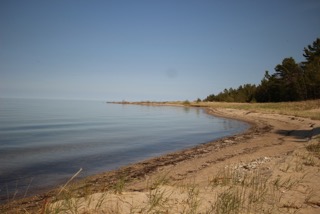
Lake Huron beach near Rogers City, Michigan. Image: Kelly vanFrankenhuyzen
By Kelly vanFrankenhuyzen
It’s too early to know if national and international attention on Flint’s municipal water crisis may tarnish the Great Lakes region’s image of pure water.
But there is a tie between the perceived quality of water and its value, experts say.
“I hope that the tourist industry gives back funding for protection and remediation,” said Joan Rose, Homer Nowlin Endowed Chair of Water Research at Michigan State University. That’s a worldwide approach “we have to do in the future,” she said. For example, there should be a tie between tourism and Peru’s challenges with sewage treatment and water reclamation at Machu Picchu.
Some countries are planning or seeking partners to make such connections, she said.
The $33 million-a-year “Pure Michigan” promotion campaign features the state’s well-known landmarks and scenes. Water plays a critical role in that campaign. And it is critical to Michigan’s top three industries: automotive, agriculture and tourism.
This year marks the 10th anniversary of the Pure Michigan brand campaign that promotes tourism, recreation, agriculture and economic development throughout the state.
The brand creates an emotional connection with consumers, whether they are Michigan natives or tourists from another country, said David Lorenz, Travel Michigan’s vice president. In 2014, 113 million visitors came to Michigan, according to the National Travel and Tourism Office. Great Lakes neighbor Wisconsin had 105 million visitors that same year.
The Pure Michigan campaign played a vital role in creating more than 200,000 jobs in the Michigan tourism industry in total in 2014, Lorenz said. The same year, more than 190,000 tourism-related jobs in total were reported in Wisconsin, according to the Oxford Economic Company Economic impact of Tourism report.
The Michigan Legislature approves the $33 million funding as part of the annual state budget. Lorenz expects the budget will be about the same for 2017.
Communities contribute some funding for the marketing. Travel Michigan works directly with 42 local partners, such as Alpena, Charlevoix, Grand Rapids, Michigan Wines and Detroit, matching about half of the marketing funds.
“Promotions for the campaign are a multi-media marketing plan,” said Lorenz. Pure Michigan appears on cable networks such as the Food Network and Travel Channel. Billboards, newspapers and magazines are also used. The campaign has a strong focus in the Midwest and is promoted through the Chicago market, which is the largest in the region, said Ken Yarsevich, an advertising specialist at Travel Michigan.
And many of those marketing and promotion plans have a connection to the Great Lakes and water.

Lake Michigan sunset near Petoskey, Michigan. Image: Kelly vanFrankenhuyzen
“When I think of water, I think of purity,” said Rose. That makes ensuring Michigan waters aren’t polluted key to the success of the Pure Michigan campaign, water users across the Great Lakes and the economy in general.
One of Pure Michigan’s commercials examines the “Potential of Water.” Michigan native and actor Tim Allen narrates the piece, addressing Michigan’s “clean lakes, clear streams and along more freshwater coastline than any other state in the country.” Following the scenic images of what the lakes offer, Allen continues, “Come realize water’s true potential. Dive into to the waters of Pure Michigan.”
And there is a lot to dive into.
Michigan has more than 3,288 miles of shorelines, 11,000 inland lakes and 36,000 miles of rivers, according to Michigan Sea Grant. The Great Lakes contain one-fifth of the world’s fresh surface water and nine-tenths of the U.S. supply, suggesting local issues can have global impacts. A Michigan State University study found more than 700,000 jobs in the state are connected to water, or one in five people.
And there is potential for even more jobs, not necessarily related to tourism.
“Water plays a critical component in our state and all aspects of it,” said Geoff Horst, chief executive officer of Algal Scientific, a biotechnological company in Plymouth, Michigan, that develops algae-based chemicals to improve animal feed and human nutrition.
Water creates a great opportunity for Michigan companies to solve critical water issues by being good stewards in the Great Lakes allowing Michigan to be leaders in the world, Horst said.
“Perhaps water and wastewater could be the next industry that Michigan could be renowned for.”
Others agree.
Michigan should be the water capital of the world, said Roy Cole, president and chief operating officer at Parjana, a Detroit company that sells water filtration and drainage methods.
Meanwhile, Flint water quality is improving, said Rose, who is on a Flint technical advisory committee that includes physicians, health officials and other citizens. “The question everyone has [about Flint water], is it good enough” since lead is still coming out of some faucets. The crisis prompted water to be tested for lead nationwide, particularly in places like schools.
The reputational consequences of the Flint crisis may not be significant statewide.
“Because of the strong connection and feeling people have for Pure Michigan, I don’t think the Flint water issues will or has damaged the relationship with the brand or the belief that Pure Michigan is a beautiful place to visit or travel or live,” Lorenz said.
But others say events like Flint can harm tourism. How long it lasts hasn’t been studied, Rose said.
“I think it could impact tourism for a short time.”
But the problems are also opportunities, she said.
Rose said model cities of the future can be built out of a disaster like Flint, and people will come and visit someday and say, “Look what they have accomplished.”
Cole said, “The first hundred years of Detroit was written by the automotive industry. The second hundred years ought to be all about water.”